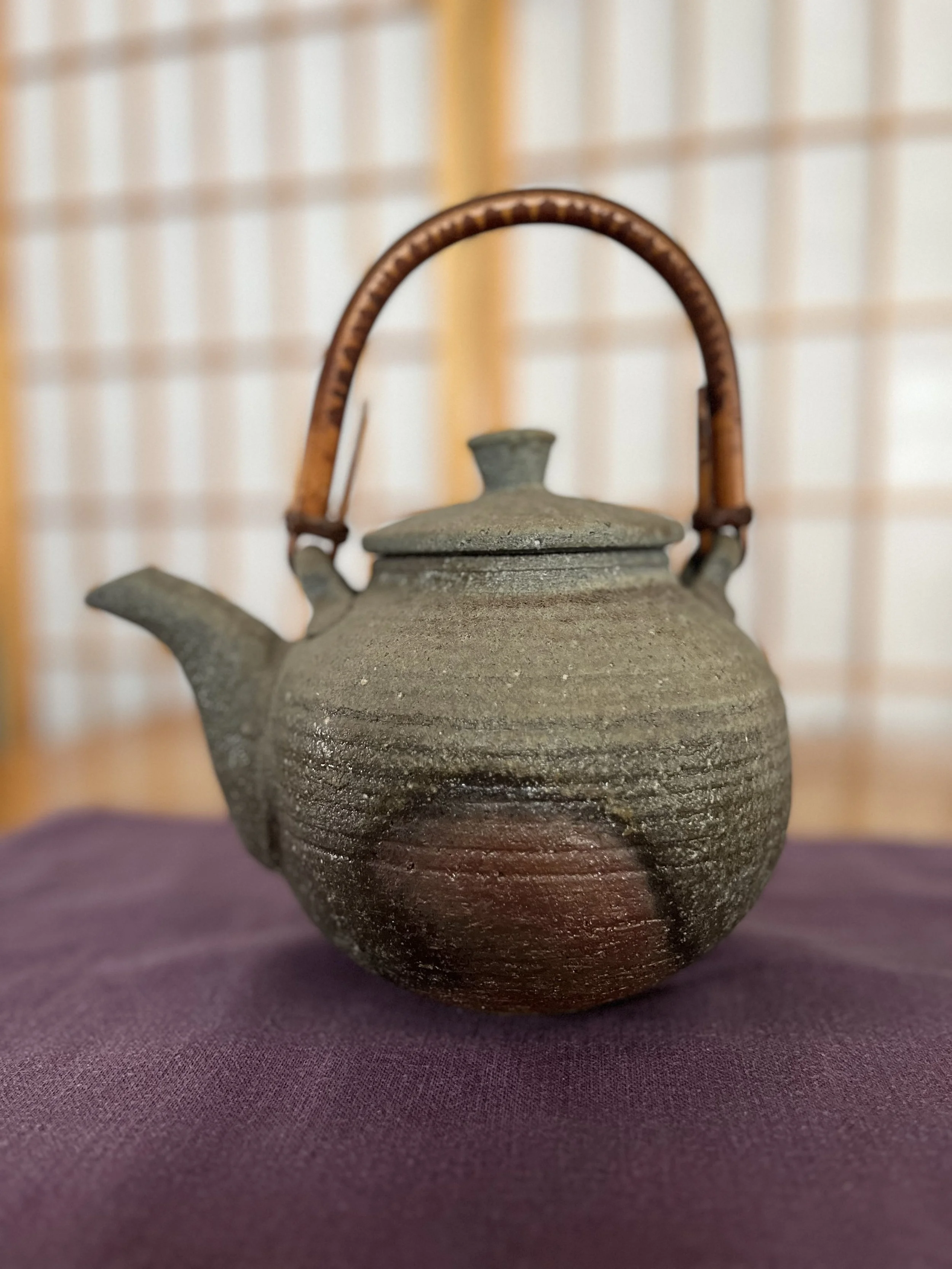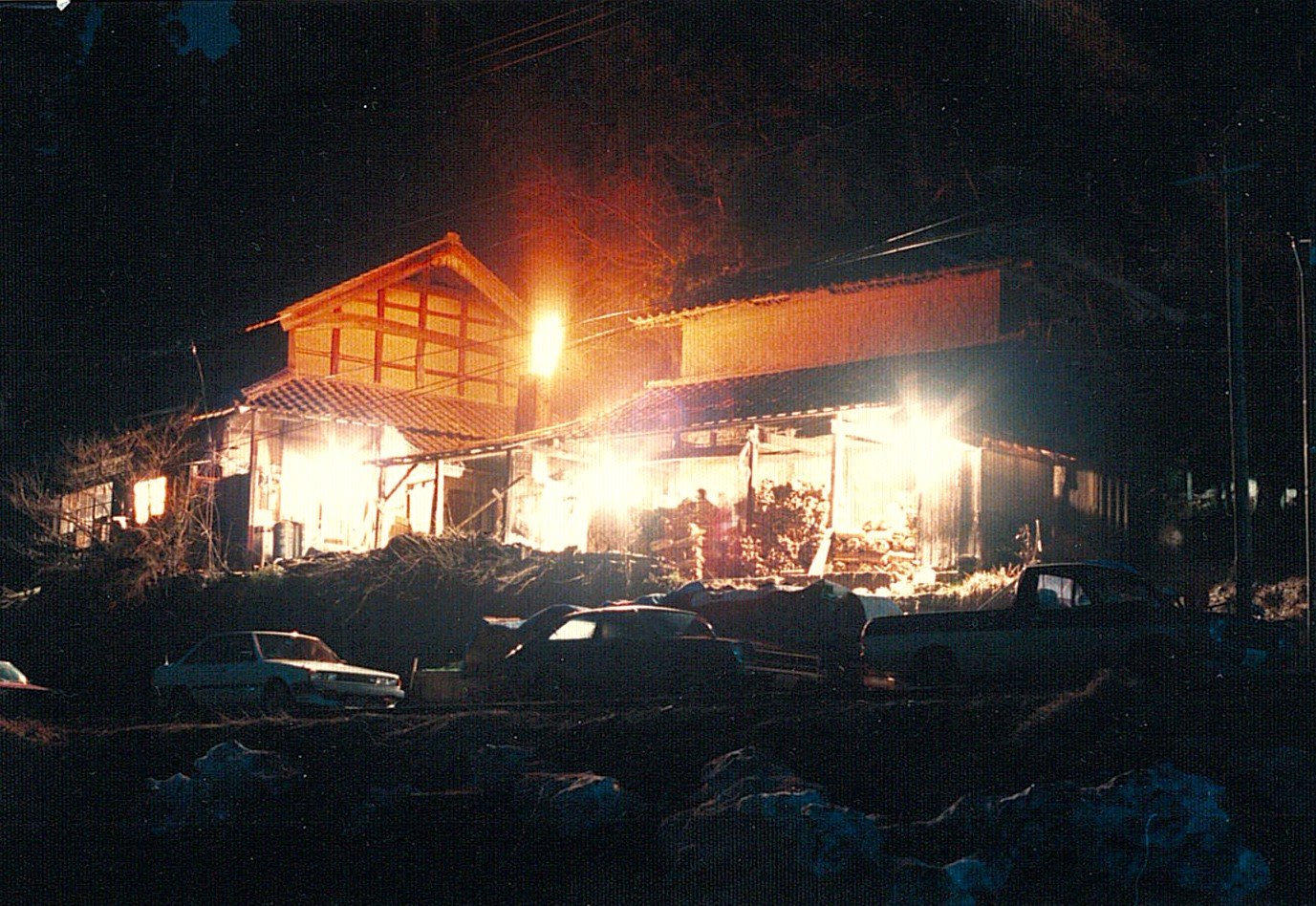幸炎 Joyous Flame (part 1)
Teapot by Ben Cohen, 1988
When I remember the late American potter Ben Cohen, I think of his name as written in Japanese. As a non-Japanese, his last name is written in katakana: コーエン (Kōen), but over the years Ben adopted kanji (Chinese characters) which express both the pronunciation of his name and the essence of his work: 幸炎 (kōen: “joyous flame”). A good name for a potter.
Ben’s studio was up a narrow country road in Fukui Prefecture. This is Ura Nihon (裏日本; the back side of Japan, on the Japan Sea), also known as “snow country” (雪国; yukiguni) for the deep, heavy snows of winter. (See: Yasunari Kawabata’s classic novel Snow Country.) The road winds and climbs through a valley lined with rice paddy fields, the hills to each side covered with cedar trees and bamboo groves. The road begins in the town of Miyazaki (now called Echizen). To one side of the road it’s a short drop into the fields. Small farm houses hug the road on the other side. From Hirono (広野; “broad field”) the road passes into Kadanji (蚊谷寺: “temple of the mosquito valley”), population 29, with eight households in total. Kadanji barely qualifies as a village.
Why “temple of the mosquito valley”? Searching local history sites in Japanese, I cannot find an answer, but I do recall being been bitten by mosquitoes in Kadanji. Mosquitoes thrive in the still waters of the flooded paddy fields. Although there is no Buddhist temple to be found, there is something sacred about this quiet place.
Lisa, my first wife, and I initially traveled that road in 1986. We were teaching in Fukui where my main job was as an English instructor at Fukui University. Lisa taught English at the local medical school, a technical college, and to private students. Our friend and bilingual protector, Takako, took us to visit Ben Cohen at his studio in Kadanji. The studio was in a dilapidated farmhouse. That expression, “dilapidated farmhouse” is applicable throughout rural Japan. Throughout the postwar era to the present, younger Japanese have abandoned the countryside to find jobs in the cities. Today’s rural Japan is a country of old people and tumbledown farmhouses. As I recall, Ben was renting the place from its owner, an old man who lived in a nearby town, for something like ¥12,000 per month, perhaps $100. The owner kept voluntarily reducing the rent until Ben ended up paying nothing at all.
Ben was originally from Chicago (his older sister, Judy Chicago, is the artist best known for her installation “The Dinner Party,” a celebration of women throughout the ages). He had arrived in Japan in the mid-1970s and, as so many English-speaking foreigners did, he taught English in Kyoto. It was there in 1976 that he met a young woman, Reiko Kakiuchi, who was working for the city of Kyoto. They fell in love and married in 1978. At the time, Ben was a painter, but eventually he chose a different path, one that took him to Fukui Prefecture, where he apprenticed for three years with an Echizen-yaki (越前焼) pottery master, Shichizaemon Kitano (北野七左衛門, 1912-1989). (Echizen is the ancient name for what is now Fukui Prefecture; yaki refers to the firing of ceramics.)
In 1981, Ben rented that broken-down farmhouse, bought and reassembled an old oil-fired brick kiln, modifying it to fire clay pots. Other potters in the area thought Ben eccentric, a hen na gaijin (変な外人; eccentric foreigner): for fuel, instead of the traditional pine, he burned cedar, which was cheaper. And who ever heard of a potter who fired his work in a brick kiln? Nevertheless, in time his work achieved a “distinct patina of red flashes, white washes, and streaks of lime green.” 1) The pots had a rough, born-from-the-earth look, very much in the tradition of Echizen-yaki, but different, clearly identifiable as Ben’s work.
By the time Lisa and I arrived in Fukui, Ben had settled into a pattern of long hours at the wheel, creating dozens of pots for firing. He continued to teach English to support his family (Reiko and he had two sons by this time). Ben was a quiet man and I think he liked the solitary, exacting work of the potter. He did not welcome visitors when he was loading the kiln with greenware, but once the kiln was sealed, the stream of visitors began, and Ben was happy to have them. Firings went on for over 50 hours and Ben needed help in stoking the kiln with the many bundles of split cedar that lined the road in front of the studio. We usually went at night, and those nights were magical: the long, slow drive up the dark, narrow road, and suddenly the sight of the chimney drawing hard on the inferno in the kiln, sparks flying into the night sky.
The night shift at a kiln firing was a party. Everyone brought food, beer, and sake. Warm sake on a cold night, skewered chicken, fried chicken, soba noodles, onigiri rice balls. The warmth of the kiln, the people huddled near it against the cold night air. Once, a photographer brought his camera and tripod and set it up in the rice field across the road and below the studio. He set the shutter for a time exposure in the dark, focusing on the chimney. He showed me how to set up my own 35mm on the tripod and I took a few shots: I still have one of the raging, glowing jet illuminating the studio and the dark sky.
Ben’s studio at night, ca 1987
I took my turn at the kiln’s stoke hole, tossing sticks of cedar into the flames. On a cold winter night, the heat was delightful. People came and went. I’m sure there was at least one kerosene heater set up to fend off the cold when sitting at some distance from the kiln. Ben’s kiln firings drew an eclectic crowd: other potters and artists; local people who liked the kokusaieteki (international) experience of hanging out with gaijin (foreigners) and having a chance to speak some English, and then there were the actual gaijin, including English teachers like Lisa and me as well as students and apprentice potters. In the night and with the help of plentiful food and drink, people opened up about themselves. Conversations seemed deeper and more meaningful, even if they were mostly forgotten in the light of the next day.
(To be continued)

